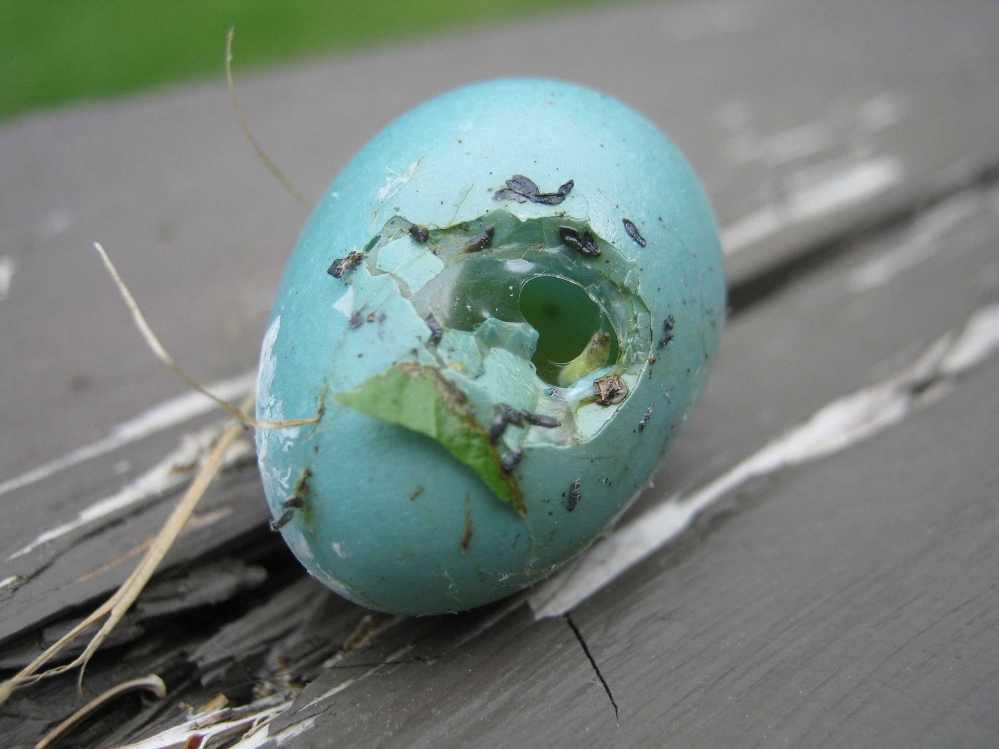One day last week there was a dead body under the deck.
I couldn’t tell what it was at first because the body was bent at angles not usually seen in three-dimensional space. Its head was mangled and twisted around backwards. Rodent-looking eyes were glaring in two or three directions, lights out. Flies were feasting on dried blood under the remains of the face. The fur had been raked, but seemed too brown and smooth to have belonged to a squirrel.
Well aware the flies would multiply and a mucky stench would rise as natural processes took over the disanimated flesh, I retrieved from the garage a shovel, and when the carcass flopped aboard I saw that it had been a rabbit. When it was alive, it was probably cute.
I knew who the slaying suspects were. At that moment they were sleeping lazily among the tomato plant pots a few feet away. Hard to piece together, from a certain frame of reference, that the same two who were purring with pleasant contentment also had twisted and torn to pieces this little rabbit, who was for all intents and purposes himself harmless. Harmless to us, I mean.
As I trudged to the woods, I made a thought experiment to imagine what the rabbit had experienced. It’s well along the way to being admitted by a preponderance of scientists that animals experience emotions that are at least parallel, if not similar or even identical to ours. So it’s probably accurate to imagine that this rabbit died terrified. I’ll spare you the rest of the nightmarish guesswork.
The cats participate in two apparently separate worlds: ours and, one step smaller, the woods of rabbits, squirrels, chipmunks, blue jays and voles. In our world they seem to be guided by certain moral behaviors such as friendship, loyalty, discretion in cleanliness, and if you can believe it, justice. (Try giving one cat food and affection, but not the other, and see what happens.) In the woods-world, they’re cold-blooded killers. And so are the fishers that, at roughly the same bio-level of forest fauna, attack and dismember cats.
The birds share that same bio-level of space with the cats, and sometimes pay the same price the cats pay fishers and foxes. Birds engage in various moral (or at least, moral-looking) behaviors such as child-rearing, nesting duties and guarding territory. (Who guards the guardians?) They share space with the next bio-level down the way we share space with cats — birds practice on butterflies and spiders the same terrors that cats practice on rabbits and that fishers practice on cats.
Whether a spider can be “terrified” is of course an empirically unanswerable question, although studies of spider fear have concluded that some individuals of the same species are braver than others. Courage being, as we recall, one of the essential moral virtues.
We’re so much bigger than our local spiders that normally we hardly notice them, even though most of the time there’s at least one within 3 feet of you. When we do notice them, as often as not the reaction is to squash it and forget it. Same with beetles, ants, etc. Things that small are out of our moral range.
Birds and rabbits are big enough to warrant a different kind of attention, in at least two ways. One is they have humanlike qualities of physiognomy and behavior that attract us emotionally. The other is that we eat them. The way cats, for example, eat rabbits.
When the cat tears the rabbit limb from limb, a certain feeling of moral nearness to the rabbit might spur indignation or even rage at the cat. But that moral feeling is completely outside the cat’s understanding. When we eat a nice, civilized chicken salad, though, the same exact range of blood-curdling terror is in the sauteed chunks of meat. It’s just been artificially disappeared by the transcendent human ability to mentally compartmentalize everything. But you know, we kill and eat birds, rabbits, deer and cows (of all things) the same way birds eat spiders, spiders eat flies, and flies feed on blood.
The corpse under the deck was kind of a shock. That shock results from us humans inhabiting a moral consciousness larger and more complex than that of a cat. But the moral overlap from human to cat, to bird and rabbit, to spider, is quite a bit larger than you normally think. A spider tooling innocently along the kitchen counter only to be suddenly annihilated by a whack from some unseen upper dimension experiences a cosmos similar to ours, where what seem for all the world like unseen forces sometimes obliterate us suddenly on a highway, or on a golf course in a lightning storm, or in the driveway shoveling snow.
If ants had nuclear weapons, E.O. Wilson once said, they’d destroy the world in two weeks.
Who are we? Where are we? And what are those lazy cats doing now?
Dana Wilde lives in Troy. His writings on Maine’s natural world are collected in “The Other End of the Driveway,” available from Booklocker.com. Backyard Naturalist appears the second and fourth Thursdays each month. You can contact him at naturalist@dwildepress.net.
Send questions/comments to the editors.


